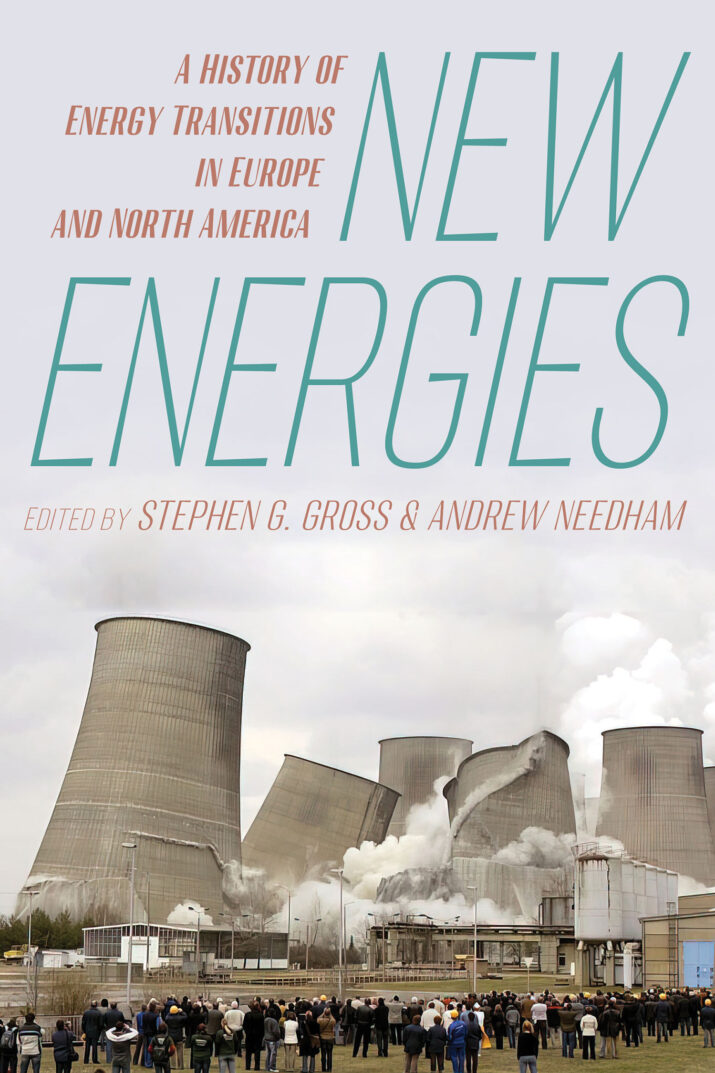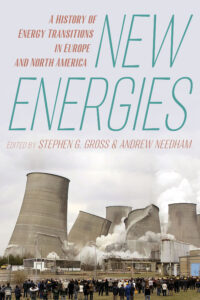
New Energies: A History of Energy Transitions in Europe and North America edited by Stephen G. Gross and Andrew Needham

In December 2023, the United Nations Conference of the Parties (COP) 28 met in Dubai to much fanfare as well as some appropriate skepticism. Although this was an international climate summit supposedly convened on the premise that global warming is real, the president, Sultan al-Jaber of petroleum exporting host country the United Arab Emirates, quickly asserted “no science” backed the idea that achieving the Paris Agreement’s temperature control objectives required ending the use fossil fuels.[1] The end results of the conference were mixed. The signatories established a loss and damage fund for countries most vulnerable to the effects of global warming, though, somewhat contentiously, the fund will be managed by the World Bank. The final memorandum for the first time called for reductions in fossil fuel use, though came of short of calling for its complete “phaseout.” Then again, what else could one expect with producers such as Saudi Arabia, Nigeria, and Iraq outright rejecting the “phaseout” language and 1300 fossil fuel lobbyists promoting their industry’s financial interests.
A global energy transition (or, more accurately, a tangle of transitions) will be necessary to achieve even a significant reduction in hydrocarbon use. This brings us to the text at hand. New Energies: A History of Energy Transitions in Europe and North America reminds us that such shifts in energy production and consumption are slippery processes. Major transitions from coal to oil to “unconventional” oil, natural gas and nuclear have occurred just over the last century. According to editors Stephen G. Gross and Andrew Needham, however, the very concept of “transition” requires qualification and must be understood
less as a discrete, punctuated shift from one stage or system of fuel to another, but rather…a layering and an ‘ongoing transformation’ that leads to new and ‘hybrid’ forms of energy provision, energy services, and energy consumption, a transformation that can reshape society in the process (15).
In short, old fuels and technologies persist and sometimes even flourish as new ones replace certain of their applications. This point is crucial to understanding these historic shifts in energy regimes as well as our current situation, wherein a complete turn from fossil fuels to a green energy mix would be historically unprecedented on such a scale and in such a compressed time.
Unprecedented, however, does not mean impossible, and this volume examines numerous historical case studies to show how energy transitions have unfolded, faltered, and succeeded in the past in order to give insight into the many possibilities that lay before our own energo-environmental predicament. The book itself is organized into four sections on the rise of petroleum, the Oil Crises of 1973/4 and 1979/80, the fits and starts of an imagined nuclear revolution, and renewable energy in the age of global warming. The period covered extends from the end of World War I through the 1990s, though most contributions focus on the 1970s as a turning point in global energy geopolitics, energy security discourses, and, ultimately, the rise of neoliberalism. Each chapter concludes with statements about what the historical case under examination reveals about the possibilities and challenges of our current moment.
The volume casts a notably wide net in terms of the fuels and feedstocks it covers. After a cogent introduction to the field of energy history as well as to the more precise transitional theme of the book, the first chapter, “The Oil from Our Soil: French Alcohol Fuel versus Foreign Oil, 1918-1957,” commences with an unconventional story: the role of biofuels in France’s gasoline mix. Here, Joseph Bohling introduces key themes that will form the linking threads through the rest of the contributions: the local and geopolitical contingencies of technological development, the fallacies in reading historical outcomes as inevitable, the social, national, and political embedment of science and economics. For mid-century France, these considerations were primary throughout a period dubbed “the century of oil.” Indeed, questions of national derivation, foreign imports, economic expense, and social cost—the latter seen in the boost the wine industry would see from alcohol-derived fuel—were as important as the omnipresent question of efficiency and, ultimately, price throughout this period.
From here, one can draw immediate connections not only to the anti-nuclear campaigns in West Germany, which Dolores L. Augustine addresses in her chapter and, per a separate monograph on the Whyl protests by Steven Milder, were also deeply connected to both terroir and wine makers along the Rhine.[2] Parallels also persist with the several studies on the impact and persistence of coal throughout what is too often considered restrictively through the lens of petroleum. In his chapter, for instance, Gross reminds us that West Germany’s transition from domestic coal to foreign oil was contested even as it coincided with “a period of unprecedented growth in the economy and unprecedented rise in total energy consumption” (49). Here, the issues were less macroeconomic—the economy of coal had been in decline for years—but more specifically socioeconomic. How could the Economics Ministry and the coal industry remove the artificial supports for such a large domestic employer while maintaining social stability? In the end, the economic straits of Ruhr coal required heavy political interventionism—nationalization, social insurance schemes, and evolving policies toward price controls—even from the ordoliberal/neoliberal Chancellor Ludwig Erhardt, who, at least in action and policy, acknowledged the social nature of economic and industrial policy. A similar point comes through in Trish Kahle’s contribution, which more directly addresses workplace safety and the Black Lung legislation in the US during the 1960s and 1970s. Here, political and social considerations necessarily intruded on the operation of a supposedly independent market.
Other chapters cover everything from cowboy extractivism and the shifting of coal production from Appalachia to the American West (Ryan Driskell Tate) to the dependencies forged by nuclear policies aimed at energy independence (Sonja D. Schmid) and the changing discourses and policies (including an industry-manufactured denialism) surrounding global warming and renewable energy in the second half of the century (Victor McFarland, Duccio Basosi, Henning Türk, Benjamin Franta, and Eva Oberloskamp). One piece that stands out in the latter category is Thomas Turnbull’s “From State to Market: A Transition in the Economics of Energy Resource Conservation.” Here, Turnbull draws our attention to a lacuna in energy studies: the missing discussion of the evolution of economic thought. In so doing, he takes the reader from the nineteenth century political economist William Stanley Jevons through a litany of progressive era thinkers in and beyond the US to later twentieth century discourses on conservation. This is where Turnbull’s piece makes its most important interventions, as he pulls aspirations for an “American lebensraum” predicated on access to foreign resources together with the Organization of Arab Petroleum Exporting Countries’ (OAPEC) embargo policy “as an act of conservation.” He then skillfully weaves in an account of the Cold War turn from “basic” to “applied” science and an embrace of the idea that energy growth and economic development could be decoupled, ultimately, through economic liberalization.
The strengths of this volume are myriad. It pulls together a wide range of scholarship, frequently either partially or completely adopting alternately transnational and comparative perspectives. Its two most eye-opening chapters, however, are Turnbull’s, which makes a strong case for the salience of economic intellectual history, and Natasha Zaretsky’s “Contamination without Representation: Fetal Citizenship and Atomic Power in the Postwar United States.” Introducing gender into the conversation, Zaretsky argues that there are strange discursive relations between the movement in opposition to nuclear energy and the anti-abortion movement in the US. This commonality lay in the former’s use of the “unborn as atomic power’s most defenseless and vulnerable victim,” which, unintentionally for many, “anticipated the central role (such characterizations) would come to play in the abortion wars of the late twentieth and twenty-first centuries” (169).
Given the nature of collected volumes and the real coherence of Energy Transitions, I hesitate to criticize any unevenness in coverage too much. However, it is worth noting that oil, coal, and nuclear energy occupy an outsized role, whereas some of the important renewables of the twentieth century such as hydro-electric and geothermal energy get short shrift. Wind and solar energy receive more attention, though the timeframe of the book restricts the need to discuss them in depth. Natural gas, moreover, a twentieth century fuel that has only increased in importance with the Russian invasion of Ukraine, also gets eclipsed by other hydrocarbons and nuclear power. In addition, few authors reflect on the specifics of the energy trade with states beyond Europe and the US. This omission includes the energy infrastructure that links these national and regional energy production and consumption networks. One collected volume cannot cover everything and this might just lay beyond the purview of the project. Still, examining such interregional connections could have exposed the complications and prospects for a more far-reaching transition even more clearly.
Then again, this is hardly the final word on the state of the field. Rather, this book is a survey of some very compelling research into the vagaries, potentialities, and realities of historic energy transitions. Not only is it essential reading to those who pursue energy history in the twentieth century, its reach also could lend itself to upper division classroom use. The chapters are pithy and digestible. They complement each other but explore discrete cases frequently informed by different methodologies and theories. What is more, the volume is timely. And, especially as the anthropocentric present becomes even more complicated, we need more works such as this to help us contextualize and comprehend the changes at hand and those necessary to affect the mammoth energy transition the moment requires.
Nicholas Ostrum received his PhD in history from Stony Brook University in 2017. He is currently an assistant professor at Kent State University and has been a member of EuropeNow’s Research Editorial Committee since the journal’s inception. Since 2021, he has also served as co-chair of the Critical European Studies Research Network at the CES. He has published articles, reviews, and pedagogical pieces in numerous journals, including The International History Review, The Journal of World History, and, of course, EuropeNow. He also contributed a chapter to the collected volume, After the Imperialist Imagination: 25 Years of Research on Global Germany and Its Legacies (Peter Lang, 2020).
New Energies: A History of Energy Transitions in Europe and North America
Stephen G. Gross, Andrew Needham
University of Pittsburgh Press
Hardback / 330 pages / 2023
ISBN: 978-0822947769
[1] David Gelles, Lisa Friedman and Vivian Nereim, “It’s Big Oil vs. Science at the U.N. Climate Summit,” The New York Times, December 5, 2023 (updated December 7, 2023). https://www.nytimes.com/2023/12/05/climate/cop28-fossil-fuels.html.
[2] Stephen Milder, Greening Democracy: The Anti-Nuclear Movement and Political Environmentalism in West Germany and Beyond, 1968–1983 (Cambridge University Press, 2017)
Published on February 15, 2024.




